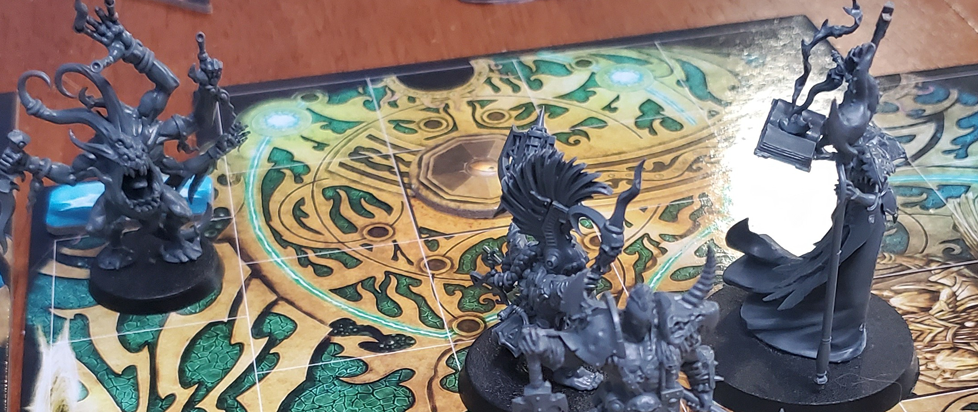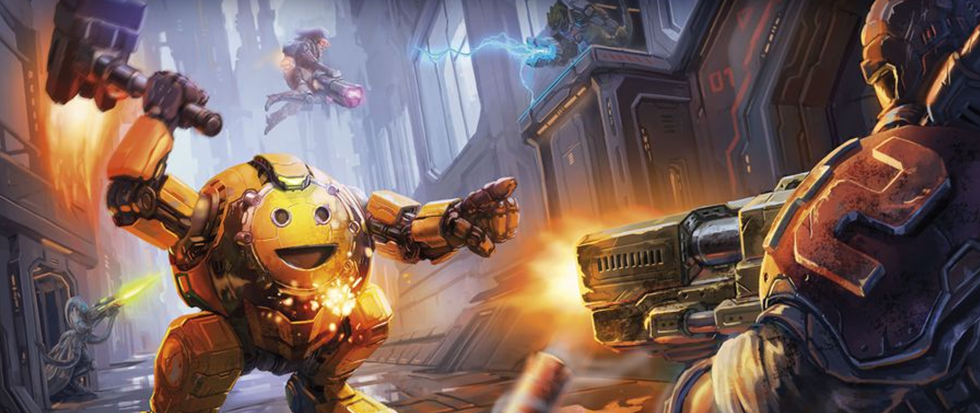
The Moorcock Connection: Sailors on the Seas of Warhammer Quest
I see board games in the store and they always look so cool and then I buy them and bring them home, I’m so excited to open them, and then I play them, like, twice… This column is dedicated to the love of games for those of us whose eyes may be bigger than our stomachs when it comes to playing, and the joy that we can all take from games, even if we don’t play them very often.
Longtime readers are probably already aware by now that I came up on Warhammer. The old Warhammer Fantasy Battles game provided one of the first fantasy settings that I ever got really into, including owning the delightful but deeply flawed original version of Warhammer Quest, one of the earliest dungeon crawl board games as we know them today.
At one time, I knew the Warhammer fantasy setting very nearly back-to-front, and was only somewhat less well-versed in Warhammer 40k. I had long since fallen out of the hobby by the time Fantasy Battles switched over to Age of Sigmar, however, and I never really put in the legwork to understand the newly revised setting until recently.
Ironically enough, it was reading the rules for Silver Tower, the Age of Sigmar-set second edition of Warhammer Quest, that made all the cogs click into place for me. One of my other early fantasy obsessions was the works of British New Wave writer Michael Moorcock, especially (of course) his Elric of Melnibone stories. And even the earliest Warhammer fantasy stuff had at least as much Moorcock as Tolkien in its DNA – where do you think those Chaos gods come from, after all?
Yet it was only reading through the rules and background that came with Silver Tower – a title that could have been plucked straight from Moorcock’s oeuvre – that I realized what Age of Sigmar really was: Games Workshop leaning hard into that Moorcockian strain of cosmic fantasy that had always been there.
There is one particular moment in Silver Tower that highlights both the delights of the game and the particular fantasy lineage to which it belongs. In some ways, Silver Tower plays much like the older version of Warhammer Quest. When your heroes pass through a doorway into a new room, you turn over an exploration card, which shows you what lies on the other side. When this happens, you read a passage in the accompanying Adventure Book, describing the room and its contents in suitably purple prose.
Sometimes, things cause unexpected events to occur. These can be new enemies pouring into the chamber, or other effects that alter how your characters perform. “The champions felt a strange and terrible sensation come over them,” one of these events proclaims, “a swooping vertigo married with the awareness of great and terrible beings controlling their actions like playing pieces on a board.”
This fourth-wall-breaking awareness on the part of the heroes causes them to resist the attempts of the players to make them act for a turn, and also underscores the cosmic scope of the game, even while its actions are restricted to a handful of cramped chambers, which fall away and disappear as they are left behind.
Shadows Over Hammerhal, which came out just a year after Silver Tower, bypasses the shifting chaos of its predecessor’s setting and also jettison’s that game’s purely co-op nature. Instead, Hammerhal requires one player to act as gamemaster, as in a TTRPG, controlling the adversaries and acting as the only person who has looked inside the Adventure Book.
Aside from that, however, the two games share more similarities than differences. In fact, heroes and adversaries from one game can be used in the other. Among the qualities the two games share is the franchise’s most innovative mechanic, which can also be seen in a modified form in Blackstone Fortress, the later, 40k-set edition of Warhammer Quest.
Every turn, each player rolls four dice for each hero they control. These dice are then placed on their corresponding hero dashboard with the rolled face showing, and are spent to perform actions on their turn. Some actions require dice showing a specific face or higher in order to pull them off, while more common actions such as moving can be accomplished with any roll.
Hammerhal adds an additional tactical wrinkle, as dice can be saved from turn to turn, but they decrease in value each time they’re saved. While I don’t have any insider information, it seems likely that this same dice mechanic influenced the design of Games Workshop’s hit skirmish wargame Warcry, which relies on a similar-yet-subtly-different approach, spending doubles, triples, etc. to activate special abilities.
It would be remiss indeed not to mention the models and tiles that come with both games. Silver Tower is aesthetically one of the most interesting dungeon crawl games I have ever seen. The room tiles themselves reflect the game’s Moorcockian cosmic fantasy influences, filled with gilt edges and impossible, curving chambers intended to represent the ever-shifting tower of the Gaunt Summoner.
The heroes are pulled into this tower from other realms, and must complete their quests not only for treasure and glory, but to escape and return to their own times and lives. This allows a built-in justification for why different heroes may come and go between sessions, plucked willy-nilly from their own worlds.
The models of Silver Tower are also top notch. Anyone even adjacent to the hobby is probably aware that Games Workshop has been producing superlative models for many years now, using what seems to be a proprietary plastic that allows for superior detail while gluing with disarming ease and staying through remarkable punishment.
Which yes, that’s one of the few downsides of Silver Tower, aside from it being out-of-print now and prohibitively expensive to buy aftermarket: you’ll have to put it together before you play. And it comes with a lot of miniatures.
For dedicated Warhammer players, this has the benefit of adding a large number of miniatures to your repertoire – you could assemble most of a solid Tzeentch-themed Chaos army just from the contents of this box. But for the uninitiated, it means picking up the supplies necessary to glue miniatures together, and learning how to do it.
The miniatures in Hammerhal are every bit as high quality as those in its predecessor, even if their variety leaves something to be desired. Where Silver Tower salted its standard Chaos forces with skaven deathrunners and an ogroid thaumaturge, to name a few, Hammerhal features mostly more Chaos followers. Which is a bit of a disappointment when the two sets are owned together, since Hammerhal seems like a perfect opportunity to add in some greater variety – orcs and goblins or skaven coming up from beneath the city all make perfect sense – rather than more Chaos stuff.
Hammerhal’s tiles suffer a similar fate. They look fine, and the art is often great, but they have both the drawback and advantage of being a more normal dungeon than Silver Tower. This makes them more versatile, sure, but it also means that Hammerhal looks more like something you’ve seen before, whereas there is still nothing else out there quite like Silver Tower, at least until someone releases a really solid Elric dungeon crawl game…





